Character Sketcher
Your job is to sketch one of the following characters:
Tom and Jack, Roger, Mrs. Rigby.
Discussion Director
Your job is to ask 6 questions, and the page and paragraph
where the answers are found. Ask good thinking questions! Ask
the following:
1 Prediction question
1 MCEOG
2 Thinking questions on your own
1 Characterization
1 Fact/Opinion
Passage Picker
Pick 4 passages that exhibit the following:
1 Description
1 Figurative Language
2 Dialect
And do the following:
1. Pick out the passage and write the page and paragraph
number.
2. Write down the first two words and last two words
of your passage.
3. What kind of passage is this?
4. Why is this that type of passage?
5. Ask and answer a good thinking question.
6. Answer one of the following questions: Why did
the author choose to include this passage? What does this passage
add to the story?
Word Wizard
Create a role sheet for the following words:
Reconnaissance p. vii line 3
Kneading p. 2 paragraph 7
Hobbyhorses p. 16 paragraph 2
Uppity p. 20 paragraph 3
1. Write down the word, page and paragraph number.
2. Copy the sentence that this word is in.
3. Write down the part of speech and what you think the
word means.
4. Look up the word in the dictionary, write YOUR definition
of the word.
5. How does this word add meaning to the story.
6. Make a word wizard card. Put the word, page
and paragraph on one side of note card and on the other draw picture to
represent the word.
Connector
Your job is to connect the book to the outside world.
Write a paragraph answering the following statement:
How does Tom and Jack’s birthday party compare to a birthday
party that you have had or been to? Explain
Literature Circle
Section 1 Answers
Character Sketcher
Discussion Director
1. On page 3 paragraph 6, Roger said that Aaron was in the quarter and that he will not be back. What do you think the quarter is and what happens to people when they go there? A confinement area where kids go when they are bad. People there are treated badly and not allowed to play or see many visitors.
2. Which of the following gifts did the twins not
receive for their birthday?
A. Tin drums B. Crusader puppets
C. Tin Soldiers D. Toy Musket
3. Describe Tom and Jack’s relationship with their parents?
Give Example.
page 24 – “No way would she like that. Your mother
find out – Whooee! Your daddy find out any o’ this craziness, we’re
all in a heap of trouble.” They hide things from their parents.
4. Given an example of how either Jack or Tom respectful
to adults?
Jack listens and smiles to Colonel Sparklehoff’s story
of the Revolutionary War. He listens to story long after he is bored,
just to humor the Colonel.
5. What example, from chapter 2, characterizes the mentality of white people toward African Americans during this time? Page 20 – when the slave children walk on the law, “Should they be gettin’ on our lawn? I don’t like that. Uppity, that’s what it is.” They have no tolerance toward blacks. They look down upon them, with no respect.
6. What evidence in the story supports Colonel Sparklehoff’s service in the Revolutionary War? On page 19, he tells how he fought with “Lighthouse Henry Lee, General Lafayette, and General Washington.”
Passage Picker
1.1 Page vii paragraph 2
1.2 “Soldiers of…wind-tossed rain”
1.3 This is a great example of a historical type of passage.
1.4 This is a historical passage because it discusses
the similarities between soldiers of both the Union and Confederate soldiers
during the Civil War.
1.5 When were the soldiers “struggling through mud, blood,
and wind-tossed rain”?
Soldiers traveled through this during battles of the
war, and on their way home.
1.6 This sentence adds a more historical description
to the scene of the Civil War.
2.1 Page 17 paragraph 5
2.2 “Staring out…a cat.”
2.3 This is a great example of a figurative language
passage.
2.4 This is a passage using figurative language because
is gives a human an animal like characteristic using the word like.
2.5 Was he really staring out of the shrubbery like a
cat?
No, Aaron was in the quarter by himself, alone.
Jack was wondering what he was doing.
2.6 This passage enables the reader to gain a visual
of what being in the quarter might be like.
3.1 Page 7 paragraph 2
3.2 “A right…frequently said.”
3.3 This is a great example of a cultural significant
passage.
3.4 This passage is culturally significant because it
strongly reflects the southern mentality during the civil war.
3.5 Who might Mr. Rigby be referring to?
He is referring to a slave, not one in particular.
3.6 The author included this passage to show examples
of how some white people in the south referred to blacks.
4.1 “You want somethin’, you scamp. Am I right?”
Page 16 paragraph 7
4.2 “You want…I right?”
4.3 This is a dialect passage.
4.4 This passage is dialect because it shows some of
the slang terms used back then (scamp).
4.5 What do you think a “scamp” is?
A scamp seems to be someone who leaches off other people
for money, help, or goods.
4.6 This passage brings some of the vocabulary from the
past to the present day.
Word Wizard
1.1 Reconnaissance – page vii line 3
1.2 “On an evening in August 1862, Tom Rigby, lieutenant
in the Sixth Union Calvary, returning from reconnaissance, rode through
a storm toward camp.
1.3 Noun – gathering information
1.4 An exploratory military survey of enemy territory
1.5 The word reconnaissance adds a little more importance
to what was going on in the story. Rather than just saying someone
was gathering information, he was on a reconnaissance mission. This
also puts things into a military perspective.
1.6
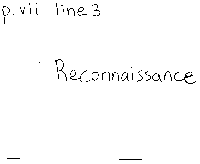
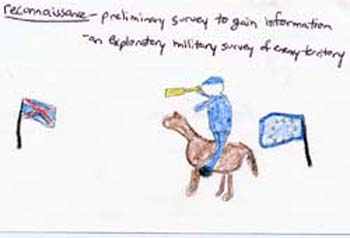
2.1 Kneading – page 2 paragraph 7
2.2 Tom laughed, got washed and dressed, and bounded
downstairs to the kitchen, where
Roger, the butler, was polished silver and Tulitha, the
cook, was kneading spongy bread dough.”
2.3 Transitive verb – rubbing in or pounding with the
hands
2.4 To work and press into a mass with or as if with
the hands.
2.5 When I hear the word kneading in this context, it
makes me visualize massaging bread dough to make cookies or bread.
2.6

3.1 Hobbyhorses – page 16 paragraph 2
3.2 “Hobbyhorses! I want a horse, not a wooden
toy.”
3.3 Noun – a stick horse
3.4 A toy with a stick for a body and a stuffed horse
head.
3.5 A hobbyhorse gives this story some timing historically.
Kids today don’t generally play with hobbyhorses, so the kids can get an
idea of just how long ago this story was, not to mention what kids their
age did during the civil war era.
3.6
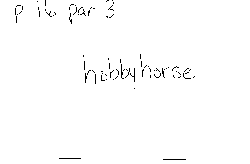
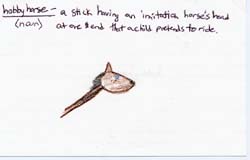
4.1 Uppity – page 20 paragraph 3
4.2 “Uppity, that’s what it is.”
4.3 Adjective – snobby
4.4 Someone who feels they are better than everyone else.
4.5 This words shows how some white people during the
Civil War acted towards some blacks.
4.6
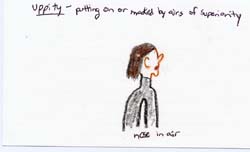
Connector
How does Tom and Jack’s birthday party compare to a birthday party that you have had or been to? Explain
My birthday parties in the past have been pretty similar
to that of Tom and Jacks. I would invite my friends over and family
(if they were in town). There would be presents given and opened.
However, I don’t think I ever received as many presents as the two boys
received. It also appeared that many of the people at their party
were kids from around the area, not just friends. However, at my
birthday parties, I would only invite my good friends, no strangers or
mere acquaintances.